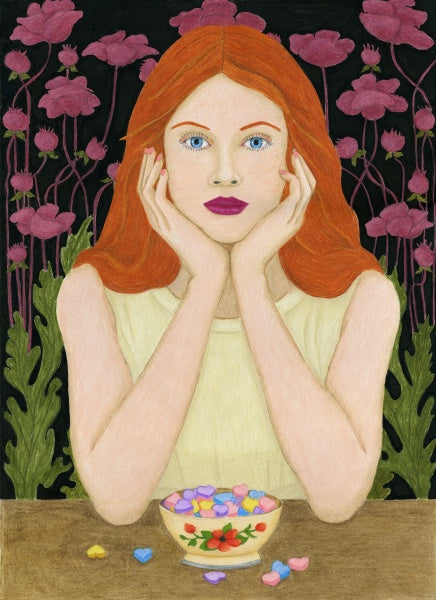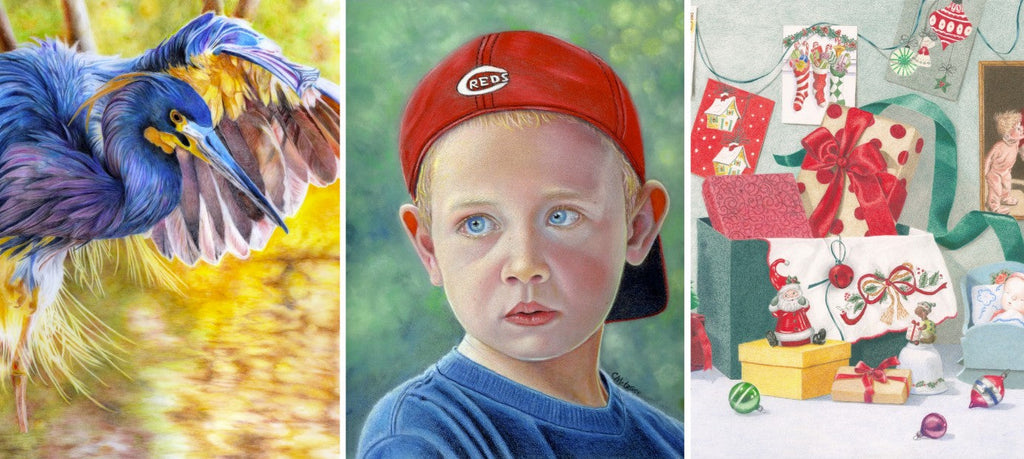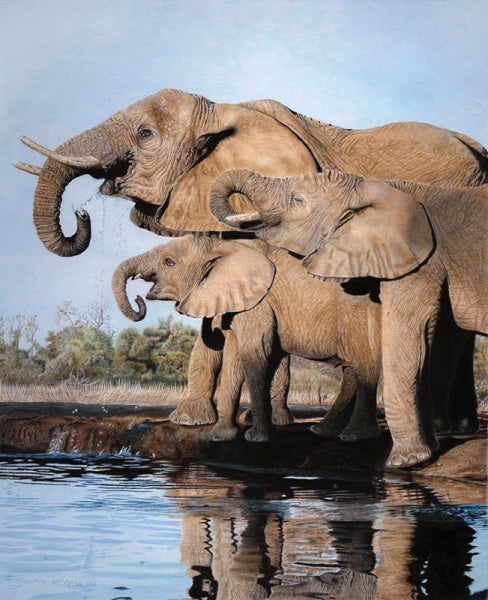A Love Affair with Colored Pencils
by Cindy Valek Mottl
My love affair with colored pencils (is it an addiction?) began around 2000 with a book called Colored Pencil Portraits by Ann Kullberg. I had moved from oils and acrylics to watercolor to find a medium that was less messy and toxic around kids and pets but needed something that gave me control for realism and packed quickly for my lake house. Then there were my cats and dogs. They enjoyed spilling my water containers and ruining my work. Armed with Ann’s book, I ordered Stonehenge paper and my first colored pencils – a complete set of Prismacolor—and set to work. “Sisters” resulted. I was hooked. Full sets of a variety of pencils followed over the years, along with open stock singles.

1st colored pencil work—Sisters, 20x26, Prismacolor on Stonehenge, reference my own
On social media artists’ groups, I see a lot of questions about the different brands and types of pencils. Lively discussions often ensue, with each artist promoting their favorite type with fervent enthusiasm. As for me, I love them all, but for different reasons depending on the subject matter, substrate, colors needed, and my mood. I’ll go through my collection brand by brand and explain what I mean.
“The combination will determine
what works best for you”
First, those Prismacolor. They are a favorite because of their range of colors and their buttery texture. I use them on all types of paper, including Grafix drafting film and Arches Aquarelle. They blend easily, play nicely with other brands when used either under or over, and have concentrated, vibrant pigments. Colors that I pull out repeatedly and haven’t found adequate substitutes for in other brands are Black Grape, many of the blues, the extensive range of greys, Pale Sage, and Grey Green. I use Black Grape for a technique that a watercolor instructor called Disappearing Purple. Used as a first layer under almost any color in area intended for shadow, it disappears but creates a rich shadowed area. White is opaque and works very well on drafting paper. Lightfastness is a concern with Prismas, but pieces I completed in the early 2000s are framed, hanging on my walls, and still vibrant. Breakage is another criticism of these pencils, but I seldom have an issue. I use a Dahle 166 sharpener which seems to solve the problem.
Polychromos pencils were my next full set purchase. They are also my least used pencils, although I have my favorites. Polys are a harder pencil; they hold a point well and have a nice range of colors. They also work with other brands on a variety of papers. Colors I use often include Bistre, Nougat, Light Flesh and Medium Flesh. Polys have a nice range of purples as well. Polys are a choice when the colors are needed for the subject matter.

Prismacolor collection storage
There’s nearly a full set of Caran d’Ache Luminance pencils in my stash. Because of their higher price, I added them as open stock singles until I had the entire range, adding the portrait set when it was released. That set is not just for portraits. It has colors that are useful for landscapes, still life, you name it. A major strength of Luminance is its lightfast quality. Pigments are concentrated, purples, pinks and reds are juicy, and the white is strong and opaque. They work well on all papers and with other pencils. My only complaints are that some of the sepias and umbers have a scratchy texture, and the older pencils have a silver lettering that wears off before the pencil runs out. Newer ones have white lettering that is easier to read and seems to last.
Derwent Lightfast = another full set, and I use almost all colors until the pencils are too small to sharpen, reordering from open stock on a regular basis. To me, their texture has the buttery feel of Prismas while being hard enough to hold a point. Again, these pencils blend well with other brands, work well on paper and drafting film, have a great range of colors, and are lightfast. The black is rich and opaque. Although I use these pencils for all subject matter, their greens and blues really shine for land and waterscapes. For my uses, there are no downsides to Derwent Lightfast.

Pencils set out and ready to work
There are several pencil brands of which I own a selection of pencils rather than a full set. Holbein is one of which I own quite a few. Vivid colors are my favorite, as well as white and soft white. Their pigment is concentrated, and they are soft enough to lay down smooth, thick layers when that technique is needed. Soft white refers to the texture of the lead, not the color. It is a bright white that I find useful to highlight over darks. I especially like Holbein on drafting film when trying to cover large areas fast. I own a few Pablo pencils. They are hard and can be sharpened to a point. Derwent Watercolor Chinese White is useful for highlighting and can be moistened to dab bright white glints. Stabilo All Black is a highly opaque, rich black, great for accents and large black backgrounds. Stabilo All White is similarly opaque, great for highlighting.
My recommendation for artists new to colored pencils or wanting to grow their collections is to try a few favorite colors from various brands. We all have different styles, different subject matter interests, and use different substrates. The combination will determine what works best for you.
CINDY VALEK MOTTL:
Cindy Mottl has been passionate about art since childhood. Trained in oils and acrylics with a B.A. in art, she transitioned to colored pencil in 2000 to bring vibrant light and color to her work. Taking her inspiration from the landscapes of northern Wisconsin and family adventures there, she seeks to put the viewer into the scene with vibrant colors expressing mood, motion and light. Cindy’s work has been featured in colored pencil publications and has been exhibited in international shows.
Website: Cindy Valek Mottl Fine Art





Comments (1)
Loved your article. and love your passion!
Pam Kromenacker - Oct 16, 2025